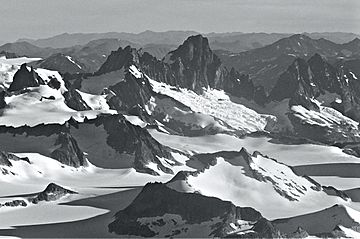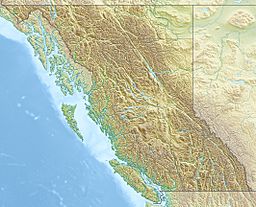Nelles Peak facts for kids
Quick facts for kids Nelles Peak |
|
|---|---|

Nelles Peak, south aspect
|
|
| Highest point | |
| Elevation | 2,531 m (8,304 ft) |
| Prominence | 1,081 m (3,547 ft) |
| Isolation | 9.27 km (5.76 mi) |
| Parent peak | Devils Paw (2616 m) |
| Geography | |
| Location | British Columbia, Canada |
| Parent range | Coast Mountains Boundary Ranges Juneau Icefield |
| Topo map | NTS 104.K.13 |
| Geology | |
| Age of rock | early Tertiary |
| Type of rock | pyroclastic |
Nelles Peak is a tall mountain in the Coast Mountains of British Columbia, Canada. It stands about 2,531 meters (8,304 feet) high. This peak is found near the edge of the Juneau Icefield. It is also about 5 kilometers (3 miles) inside the border between British Columbia and Alaska. You can find it on the west side of Tulsequah Lake.
The mountain's closest taller neighbor is Devils Paw, which is about 9 kilometers (5.6 miles) to the southeast. Nelles Peak is actually the second-highest point in the entire Juneau Icefield, right after Devils Paw. The mountain was named in 1924 to honor Douglas H. Nelles (1881–1960). He was a Canadian engineer who worked on the International Boundary Survey in 1907. The name became official in 1947, approved by the Geographical Names Board of Canada.
Mountain Weather and Climate
Nelles Peak has a subarctic climate. This means it has cold, snowy winters and mild summers. Most of the weather comes from the Pacific Ocean. These weather systems travel east towards the Coast Mountains. When they hit the mountains, the air is forced upwards. This causes the air to cool and drop its moisture as rain or snow. This process is called Orographic lift.
Because of this, the Coast Mountains get a lot of rain and snow. This is especially true during the winter months. Temperatures can drop below -20 degrees Celsius (-4 degrees Fahrenheit). With the wind, it can feel even colder, sometimes below -30 degrees Celsius (-22 degrees Fahrenheit). Water from melting snow and ice on Nelles Peak flows into the Tulsequah River. This river then empties into the larger Taku River. If you want to see or climb Nelles Peak, July usually has the best weather.



